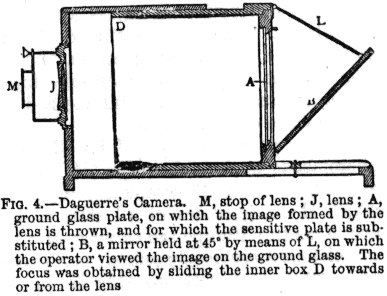Early Photography
Today, let's look at some old pictures. The University of Houston's College of Engineering presents this series about the machines that make our civilization run, and the people whose ingenuity created them.
The camera was invented in two stages. The camera obscura has been known for 2000 years. A camera obscura casts an image that an artist can trace. One photographic tracing of that kind shows us, quite accurately, what George Washington looked like.
But we've only had means to record a camera's picture for 160 years. Thomas Wedgwood -- son of the great industrialist -- first recorded images on a coat of silver nitrate. But his pictures were only fleeting. He had no way to fix the image.
Two Frenchmen, Joseph Niepce and Louis Daguerre, finally gave us permanent camera pictures in the early 1800's. The engraver Niepce got there first when he spread a bitumen slurry on a pewter plate. Prolonged exposure to light made the bitumen water-soluble. He washed away the soluble bitumen after he'd exposed the plate in a camera. Then he etched the pewter where it was uncovered.
Daguerre was a theatre set designer who made heavy use of the camera obscura in his work. He too was trying to find a way to record pictures. For several years, he and Niepce sniffed at each other like wary tomcats. Finally, in 1829, they decided two heads were better than one, and they formed a partnership.
Niepce died three years later, and Daguerre eventually replaced the bitumen with silver iodide. He gave us the Daguerreotype.
Niepce's first picture was a slightly fuzzy, eight-hour exposure of the view from his apartment window, made in 1826. The first Daguerreotypes needed only 15 minutes of exposure. They date from the latter 1830s, and they are handsome pictures.
We see faces that have been carved by harsher lives than we live today. But even with people in them, these first pictures are carefully composed still lifes -- objects of art in classical poses.
By the 1860s things had changed. Exposures were much quicker, and attitudes were less romantic. The world was increasingly functional and industrial. Photography turned to documentary reporting -- the joining of the transcontinental railway, an absolutely radiant young Sarah Bernhardt, a wild-eyed Baudelaire. And another thread appears. We see rotting corpses of Civil War dead and child laborers in factories. We see the urban poor. By the 1860s photography had become social commentary and a self-conscious historical record.
Photography began as an unsolved technical problem -- a teaser of the imagination. In just 30 years, it had turned into an extension of our conscience.
I'm John Lienhard, at the University of Houston, where we're interested in the way inventive minds work.
(Theme music)
Newhall, B., The History of Photography. New York, The Museum of Modern Art, 1964.

From the 1897 Encyclopaedia Britannica